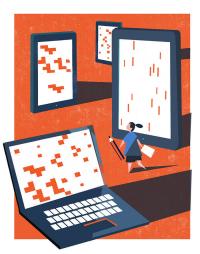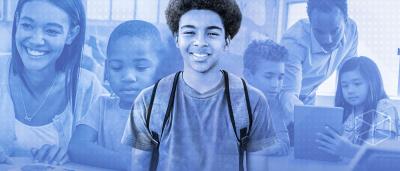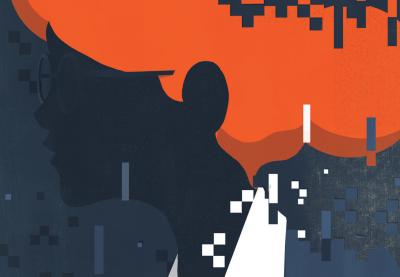As a sophomore at Boston International High School, Kendell Solis failed an English class. Two years later, then an 18-year-old senior, Solis discovered he still needed the credit to graduate. So he enrolled in an online English class as part of Boston Public Schools’ online credit-recovery program, which lets students take online versions of classes they failed in a brick-and-mortar setting. Solis passed the class—which ostensibly covered the same material—but wonders how well he learned to read English.
“It was kind of easy, from my perspective,” says Solis, a recent immigrant and English language learner (ELL). “It felt good because I got to recover my grade. … But at the same time I would read better if I hadn’t failed my sophomore year. I guess I would have learned more from my sophomore year than what I did from the credit recovery.”
Stories like Solis’ are becoming increasingly common as schools and districts, under national and local pressure to bolster student achievement, are turning to online courses as an inexpensive option for keeping struggling students on the path to graduation. But critics worry that using online schools indiscriminately and without proper support simply masks achievement problems by enrolling at-risk, disadvantaged or ELL students in easier online credit-recovery courses.
That’s exactly what happened in Manhattan’s Murry Bergtraum High School for Business Careers. In spring 2014, media reports surfaced alleging the school was funneling hundreds of students through nonrigorous online classes to boost grades and graduation rates.
“Technology in education has been my thing for a very long time,” says John Elfrank-Dana, a whistleblower teacher at Murry Bergtraum. “I get really annoyed when I see abuse; when I see kids stuck in front of computers and the goal is just to get the school’s numbers up. And that’s what’s been going on.”
The Credit Recovery Question
A 2010 survey by market research firm Simba Information found that online credit-recovery courses constituted about half of all K-12 virtual education in the United States. But how well these students fare in the long run remains the big question in the online credit-recovery debate; the growth of virtual education has outpaced academic research.
Since 2006, University of California Santa Barbara Professor of Education Russell Rumberger has tracked California’s K-12 graduation landscape as director of the California Dropout Research Project. He’s taken notice of the growing use of online credit recovery to battle California’s dropout problem and attributes a recent 4-percent uptick in the state’s graduation rate to a national focus on graduation—and, perhaps, to online credit-recovery courses.
“Unfortunately, I don’t think we have any real data on it,” Rumberger says, “but just anecdotally I know it’s grown. … The traditional way was making up a course or doing independent study. Now there’s more computer-based credit recovery going on.”
On its face, online credit recovery is a success: A student who was failing earns a diploma. But Rumberger voices a common question: Did that student actually learn the material?
“The jury is still out about their effectiveness,” Rumberger says. “The concern I have is that it’s not as rigorous, and therefore it’s not really a replacement for taking regular classes. It’s kind of a shortcut.”
A shortcut that is often applied to vulnerable, at-risk students.
“Those are the kids who are most likely to fail classes,” Rumberger says.
Supporters point out that credit-recovery opportunities for these students can be the difference between leaving school with a diploma and just leaving school. Boston Public Schools’ Credit Skills Recovery Program (CSRP), for example, offers an online avenue for “old and close” students like Solis, age 18 or older and within a few credits of graduation. A 2012 University of Massachusetts evaluation tracked 441 students entering the CSRP, 90 percent of whom had been flagged as “high risk” individuals; 350 of them earned a diploma.
Salman Al Janabi, an 18-year-old Iraqi immigrant in the Boston Public Schools system, fit neatly into the “old and close” mold and was working toward graduating via online credit recovery in spring 2014.
“The online class is OK, but there’s nobody next to you to explain what is the next step—you have to figure it out on your own,” Al Janabi says. “I don’t like this format. I like the one-on-one with a teacher explaining it to me—like in a class.”
At-risk students need teacher attention, positive social interaction and encouragement—and virtual education gives them less of those things.
‘Social Impoverishment’
The handful of students tapping away at computer stations on a Tuesday morning at Oregon Trail School District’s Blended Learning Center (BLC) seem intent on their work. The BLC opened in 2012 and serves students ranging from competitive skiers who travel a lot to the children of itinerant laborers. These students take computer-based classes in a brick-and-mortar school setting.
It’s a popular program capped at 200 students with a long waiting list and an 85-percent graduation rate. But the BLC has the feel of a library, silent and austere. If these students are socializing, it’s happening elsewhere.
This kind of setting concerns Marie-Nathalie Beaudoin, author of Boosting ALL Children’s Social and Emotional Brain Power: Life Transforming Activities. Students don’t just learn from the academics of school, Beaudoin says. They learn just as much through socialization, forging connections with teachers and learning about differences in race or socioeconomic status with their peers.
“I’m very concerned by the fact that so many children will have impoverished social and emotional education through this process,” Beaudoin says of virtual education. “The socialization process of children is one of the most important aspects of their development.”
Many experts point out that school is just one of the ways that children socialize; social emotional learning can also happen at church, on a sports team or in activities, such as band or choir. But where a student lives and attends school often impacts his access to extracurricular activities, and not all families have the time or resources to seek them out.
“If the environment is already impoverished … in any way, the virtual education would just be another way of impoverishing that child’s development,” Beaudoin says.

Virtually Inappropriate
In August 2012, Darcy Bedortha took a job as an English teacher for Insight School of Oregon, a virtual charter school run by K12 Inc., the nation’s largest private K-12 online education company. By the following fall, Bedortha had 476 students in 30 different classes. She’d never communicated with most of them. In November 2013, she quit.
Insight School of Oregon focuses on at-risk students. Bedortha is still haunted by the stories of the students she wasn’t able to serve.
“The typical student would be on the fringes and not quite fitting in,” Bedortha recalls. “They would talk about self-harm, and they would talk about surviving suicide. It’s the stuff where you want to be able to visually see these kids and make sure that they’re OK. All I would get was a piece of paper.”
Bedortha’s experience illustrates an important point: At-risk students need teacher attention, positive social interaction and encouragement—and virtual education gives them less of those things.
Education tech expert Michael Barbour, director of doctoral studies at the Isabelle Farrington College of Education and assistant professor of educational leadership at Sacred Heart University, has studied virtual education since its infancy. He notes that the first attempts at virtual education focused on serving high-achieving students with offerings such as Advanced Placement classes and foreign language courses not available in a school or district. Those efforts were largely successful and continue to be, Barbour points out, because they focused on driven, self-starting students who often came from academically achieving families and communities. For an at-risk student with less structure, however, virtual education may mean little or no actual learning.
“If you’ve got a parent that is really hands off and lets their child pretty much do it on their own, those students, if they don’t have that internal self-directedness, self-regulation, self-motivation, those students tend not to do well,” Barbour says. “But that’s true in a brick-and-mortar environment as well.”
Barbour’s opinion is common among those who study K-12 education. Many experts point out that virtual education models can work very well when students are matched with the appropriate program and levels of adult support, but otherwise can actually exacerbate the deficits at-risk students experience.
Bedortha didn’t feel her at-risk students were served well by the adults who signed them up for virtual school. Rumberger questions whether at-risk students in California are being cheated out of learning their coursework. Time will tell if Solis, an ELL student who wants to go to college, was given an adequate education. The answer to that question will come when the world after high school decides how well he can read.
The Language of Virtual Education
Virtual learning refers to using computer software, the Internet or both to deliver instruction to students. The explosion of K-12 virtual learning options has yielded a variety of models designed for students in different circumstances. Here’s a breakdown of some of the most commonly used terminology surrounding virtual learning.
Blended learning: A learning model that combines virtual learning and in-person teaching. Teachers and counselors provide variable levels of support depending on the environment.
Computer-based classes: A general term referring to courses in which the teaching and assessment are entirely conducted and administered via computer software or the Internet.
Distance learning: A teaching method in which lectures are broadcast or classes are conducted by correspondence or over the Internet without the student physically attending school.
Full-time virtual schools or programs: Distance education programs that offer a spectrum of full-time online curricula. Often utilized by students who parent or work full time, or who do not thrive in a traditional school setting. Increasingly relied upon to supplement or supplant home-school offerings.
Home-based credit-recovery programs: Credit recovery available via institutions that teach courses entirely online. May be taken whether or not the student is enrolled in school.
School-based credit-recovery programs: Credit recovery courses taken during normal school hours, after school, on vacation breaks or over the summer. Typically taken by students currently enrolled in school.
Virtual charter schools: Full-time online schools that receive public funding but are not subject to the same regulations as public institutions. Some are run by for-profit educational management institutions.

